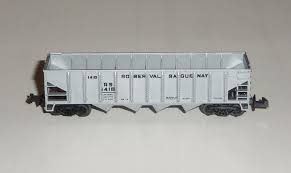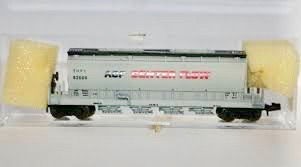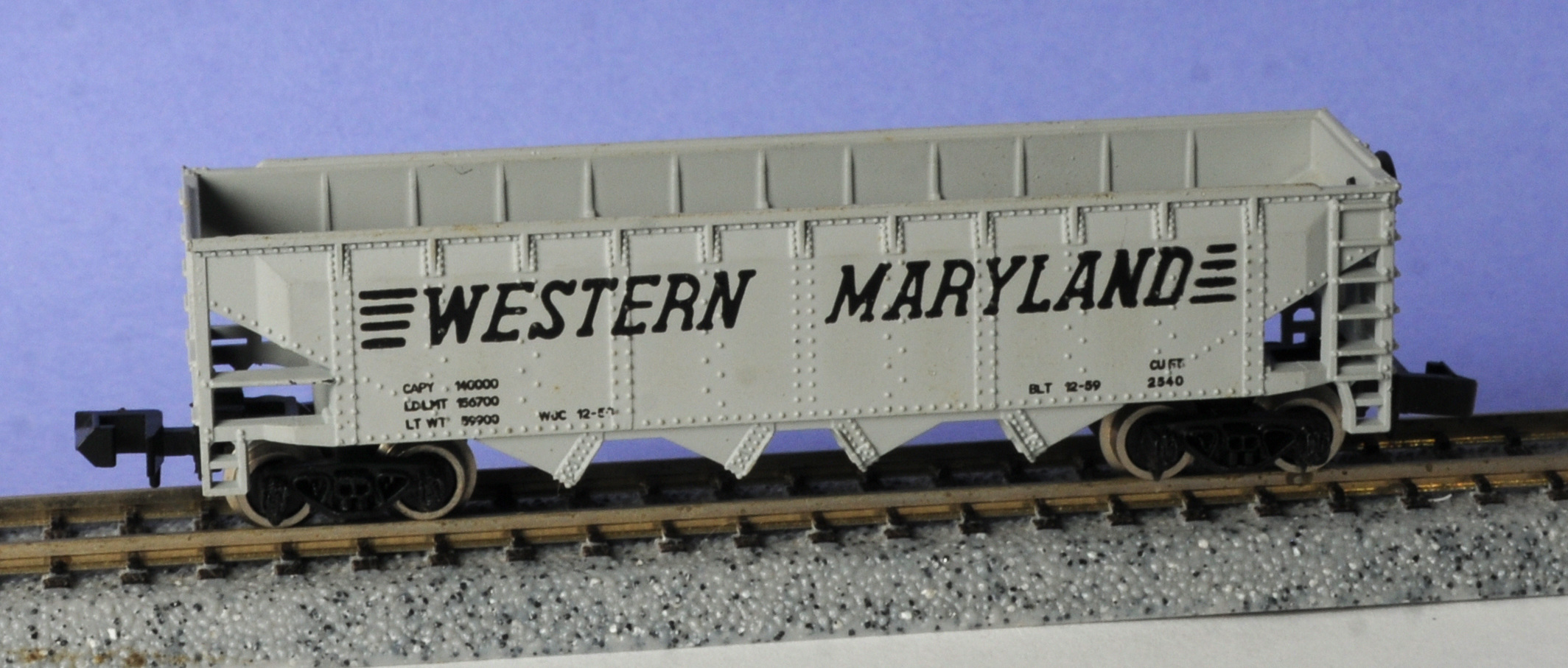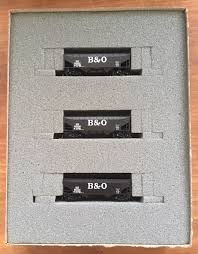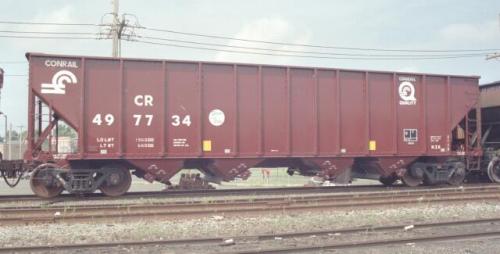Model Information: Roco made 2 different 4-bay open hopper N Scale models in the late 1960s/early 1970s. This one is the rib-side version and the other one is an offset side. At first glance, it is fairly easy to confuse the two. The rib-side versions were made for AHM specifically and were stamped 'AHM Austria' on the bottom. They were later imported for a brief time by another company called JC Timmer in CP paint schemes. Walthers also imported these with Roco branded boxes. I have to assume that the stamping on the JC Timmer and Roco versions do NOT say 'AHM Austria' on the bottom.
Overall it is a pretty nice tooling for its time. The molded details are quite fine and even include rivet patterns on the interior. I have seen 3rd generation models with less detail inside the cargo area. The AHM versions have blackened metal wheels whereas the JC Timmer and Roco versions have nickel-silver plated wheels. The couplers are truck mounted (no surprise given the age of this tooling).
Overall it is a pretty nice tooling for its time. The molded details are quite fine and even include rivet patterns on the interior. I have seen 3rd generation models with less detail inside the cargo area. The AHM versions have blackened metal wheels whereas the JC Timmer and Roco versions have nickel-silver plated wheels. The couplers are truck mounted (no surprise given the age of this tooling).
Prototype History: The 1960s brought about a growth in car size (and capacity). Railroads that transported coal moved away from the older 2-bay 55-ton USRA standard to newer 90- and 100-ton three bay hoppers. These cars were effective and long-lived. Many railroads swapped out the trucks on these cars to increase the capacity to 100 tons. Many companies produced these, including Pullman, Bethlehem, Evans, Greenville, Trinity and Ortner. The offset side variant of these hoppers carried a little more capacity than their rib-sided cousins.
Road Name History: 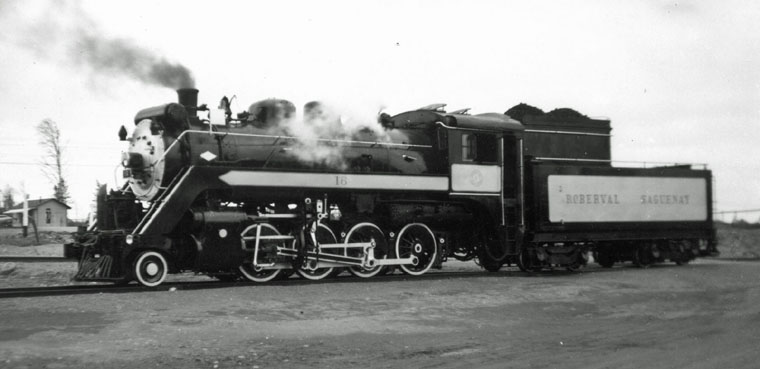 This line is often referred to as Roberval & Saguenay but you won’t find the & anywhere on an RS locomotive or car. The RS was launched in 1911 to build from a connection with the Quebec & Lake St. John Railway in Roberval, Quebec, around Lake St. John to Chicoutimi with a branch to St. Bruno. The line was owned by the Chicoutimi Pulp Company. In 1914, RS acquired the Ha! Ha! Bay Railway that ran from Jonquieres to Bagotville plus branches. A portion of the line was under trolley wire with steeple cab switchers moving the freight while steam was used on the rest of the system. RS settled in hauling forest products until the owners closed the mills in 1925.
This line is often referred to as Roberval & Saguenay but you won’t find the & anywhere on an RS locomotive or car. The RS was launched in 1911 to build from a connection with the Quebec & Lake St. John Railway in Roberval, Quebec, around Lake St. John to Chicoutimi with a branch to St. Bruno. The line was owned by the Chicoutimi Pulp Company. In 1914, RS acquired the Ha! Ha! Bay Railway that ran from Jonquieres to Bagotville plus branches. A portion of the line was under trolley wire with steeple cab switchers moving the freight while steam was used on the rest of the system. RS settled in hauling forest products until the owners closed the mills in 1925.
A predecessor of Alcan bought the railroad to move raw material and finished products from their new aluminum smelters in Arvida. In 1929 the line was extended from Arvida northwest to a connection near L’Ascension. In 1974, the Alma & Jonquires Railway (also owned by Alcan) was merged into the RS.
Traffic today is dominated by raw material to and finished products from the aluminum smelters plus some forest products. A recent locomotive roster includes an S2, two RS-18’s, two RS-3’s, an RS-11, a C420, two B23-7’s, eight GP38-3’s and three SD70Ace’s.

A predecessor of Alcan bought the railroad to move raw material and finished products from their new aluminum smelters in Arvida. In 1929 the line was extended from Arvida northwest to a connection near L’Ascension. In 1974, the Alma & Jonquires Railway (also owned by Alcan) was merged into the RS.
Traffic today is dominated by raw material to and finished products from the aluminum smelters plus some forest products. A recent locomotive roster includes an S2, two RS-18’s, two RS-3’s, an RS-11, a C420, two B23-7’s, eight GP38-3’s and three SD70Ace’s.
Brand/Importer Information:  AHM is the initials for Associated Hobby Manufacturers, Inc. The company was founded in 1959 as a reseller of other companies' model railroad components. Initially an HO company, they entered into N Scale in the early 1970's as an importer of products made by Roco in Austria. For N Scale products, AHM apparently contracted to use the exact same molds as were used by Roco to produce early Atlas models. They also contracted with Rivarossi to make locomotives.
AHM is the initials for Associated Hobby Manufacturers, Inc. The company was founded in 1959 as a reseller of other companies' model railroad components. Initially an HO company, they entered into N Scale in the early 1970's as an importer of products made by Roco in Austria. For N Scale products, AHM apparently contracted to use the exact same molds as were used by Roco to produce early Atlas models. They also contracted with Rivarossi to make locomotives.
When AHM went out of business IHC picked up some of their line. Also, at least one body style was taken over by Eastern Seaboard models.

When AHM went out of business IHC picked up some of their line. Also, at least one body style was taken over by Eastern Seaboard models.
Manufacturer Information:  The company was founded in 1960 by Ing. Heinz Rössler and started with a plastic Minitanks series of military vehicles. After export to the USA became successful, the model line was expanded with model trains in HO scale and the smaller N scale. TT scale was also subsequently added to the product line. The model rail product line covers many European countries including Germany, Belgium, Luxembourg, France, Spain, Austria, Italy, Switzerland, Sweden and the Netherlands, and also the USA.
The company was founded in 1960 by Ing. Heinz Rössler and started with a plastic Minitanks series of military vehicles. After export to the USA became successful, the model line was expanded with model trains in HO scale and the smaller N scale. TT scale was also subsequently added to the product line. The model rail product line covers many European countries including Germany, Belgium, Luxembourg, France, Spain, Austria, Italy, Switzerland, Sweden and the Netherlands, and also the USA.
On July 15, 2005 ROCO Modellspielwaren GmbH was declared bankrupt. From July 25 the company continues as Modelleisenbahn GmbH, but still uses the Roco brand and associated logo. On October 1, 2007, distribution of the 'Minitank' product series was assigned to the German model car manufacturer Herpa.
Since February 2008 Modelleisenbahn also owns Fleischmann, which like Roco had gone bankrupt. The two companies continue as separate brands under Modelleisenbahn GmbH, while benefiting from economies of scale through joined development projects, marketing and procurement.
From Wikipedia

On July 15, 2005 ROCO Modellspielwaren GmbH was declared bankrupt. From July 25 the company continues as Modelleisenbahn GmbH, but still uses the Roco brand and associated logo. On October 1, 2007, distribution of the 'Minitank' product series was assigned to the German model car manufacturer Herpa.
Since February 2008 Modelleisenbahn also owns Fleischmann, which like Roco had gone bankrupt. The two companies continue as separate brands under Modelleisenbahn GmbH, while benefiting from economies of scale through joined development projects, marketing and procurement.
From Wikipedia
Item created by: gdm on 2016-12-01 08:43:11. Last edited by CNW400 on 2020-06-10 11:43:17
If you see errors or missing data in this entry, please feel free to log in and edit it. Anyone with a Gmail account can log in instantly.
If you see errors or missing data in this entry, please feel free to log in and edit it. Anyone with a Gmail account can log in instantly.


